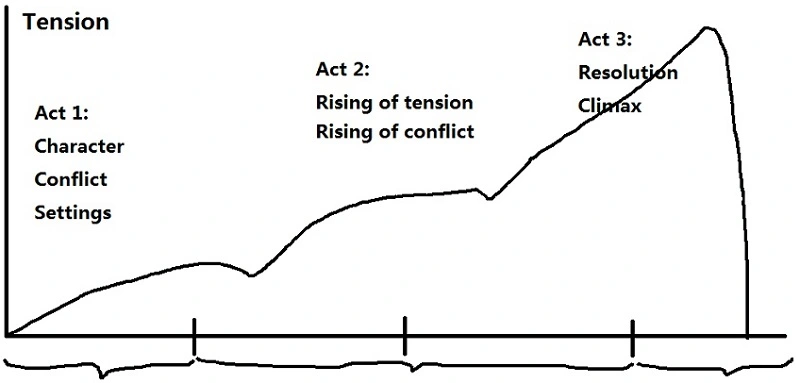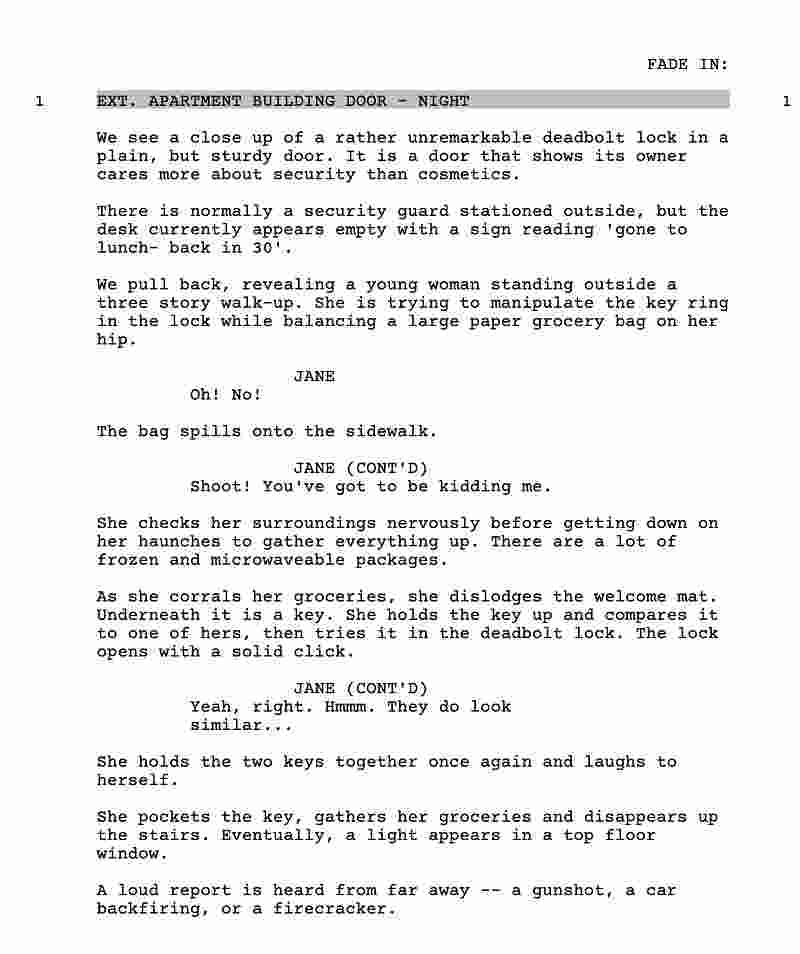
Many filmmakers underestimate the importance of a well-written screenplay. They assume that any ‘exciting narrative’ will sparkle on screen, but this hardly pans out so.
While everyone wants a movie that succeeds at the box office and on other fronts, no matter how engaging the story is, bringing it to life on screen is a different ballgame.
So how do you develop a screenplay that captivates viewers or leaves a lasting impression?
Creating a screenplay that captivates viewers and leaves a lasting impression demands creativity, dedication and a good understanding of storytelling.
In this piece, we will explore the fundamentals of writing a successful screenplay. From story structure to mastering the art of rewriting and editing.
- What are the elements of a good screenplay?
- Key Takeaways
- Understanding Screenplay Structure
- Writing A Winning Screenplay – The Three-Act Structure
- Developing Memorable Characters
- Writing A Winning Screenplay – Creating A Compelling Plot
- Writing A Winning Screenplay – Format
- Rewriting and Editing
- Navigating the Industry
- Frequently Asked Questions
- What are the key elements of a compelling screenplay?
- What strategies can beginners employ to master screenwriting?
- How can one effectively develop characters in a script?
- What are common pitfalls to avoid when writing a screenplay?
- How can I structure a screenplay to maximize audience engagement?
- What techniques contribute to creating a successful fantasy screenplay?
- How can I find a Screenwriter to work on my story?
Whether you are a writer, producer, or filmmaker, these tips will help you craft compelling screenplays. So let’s dive into the elements of a good screenplay.
What are the elements of a good screenplay?
Plot (Sequence of events)
A good screenplay should have a well-structured plot, engaging characters, and compelling dialogue while adhering to strict formatting guidelines. But what is a plot?
In a literary work, film, or other narrative, the plot is the sequence of events in which each event affects the next one through the principle of cause and effect. It is the series of events in a story.
It would ‘come’ with a clear beginning, middle, and end, along with a well-defined plot that keeps the audience engaged from start to finish.
Characters
A character is someone in a story—a human being, an animal, or a mythical creature. Characters have unique traits that define them and influence their actions in the story. Developing memorable characters is crucial, as they are the heart of any great screenplay.
Dialogue

Dialogue is the spoken interaction between two or more characters. However, characters can also have internal dialogue.
When written, the dialogue is a spoken conversation punctuated with quotation marks delineating the separate speakers.
Through dialogue, writers add depth to their characters, depict realism in the story, advance the plot line, and intensify the conflict. Writing dialogue that moves the story forward is essential.
The Screenplay Format
Mastering screenplay format is another essential aspect of successful screenwriting. Screenplays must adhere to strict formatting guidelines, including font size and style, margins, and spacing.
Rewriting And Editing
Rewriting and editing are also critical components of the screenwriting process, as they allow you to refine your work and make it the best it can be.
Navigating the industry and protecting your work are also important considerations for aspiring screenwriters. By honing your skills and mastering these key elements, you can increase your chances of writing a successful screenplay that resonates with audiences.
Key Takeaways
- Understanding screenplay structure is essential to crafting a successful screenplay.
- Developing memorable characters and crafting engaging dialogue are crucial elements of successful screenwriting.
- Mastering screenplay format, rewriting and editing, and navigating the industry are also important considerations for aspiring screenwriters.

Understanding Screenplay Structure
Screenplay structure is the foundation of a successful screenplay. It is important to understand the structure before starting to write a screenplay. A well-structured screenplay can keep the audience engaged and make them emotionally invested in the story.
READ ALSO: The Best Screenwriting software to craft a compelling story
Writing A Winning Screenplay – The Three-Act Structure

The three-act structure is the most commonly used structure in screenplay writing. It divides the screenplay into three parts: the setup, the confrontation, and the resolution.
The first act sets up the story, introduces the characters, and establishes the world of the story. The second act is where the protagonist faces the main conflict of the story. The third act is where the conflict is resolved and the story comes to a conclusion.
The three-act structure provides a clear framework for the story, making it easier for the writer to develop the plot and characters. It also helps the audience to follow the story and understand the character’s journey.
Plot Points and Beats
Plot points and beats are important elements of screenplay structure. Plot points are major events that happen in the story, which move the plot forward. They are usually placed at the end of each act. Beats are smaller events that happen in between plot points. They are used to develop the characters and move the story forward.
A well-structured screenplay has a balance between plot points and beats. Too many plot points can make the story feel rushed, while too many beats can make it feel slow and uneventful. It is important to find the right balance between the two.
Understanding screenplay structure is essential to writing a successful screenplay. The three-act structure and plot points and beats are important elements of screenplay structure that can help the writer to develop a well-structured and engaging story.
Developing Memorable Characters

Creating memorable characters is essential for any successful screenplay. Audiences need to connect with the characters in order to become invested in the story. Here are some tips for developing memorable characters:
Character Arcs
Characters should have a clear arc, or journey, throughout the story. This means they should start out with a certain set of beliefs or values, and then undergo a transformation as a result of the events of the story.
This transformation should be visible and meaningful, and should ultimately lead to the character’s growth or change.
Dialogue and Voice
Dialogue is a key component of character development. Characters should have their own unique voice and way of speaking that sets them apart from other characters. This can be achieved through word choice, sentence structure, and even accents or dialects.
Additionally, characters should be given dialogue that is true to their personality and motivations. This means avoiding generic or clichéd lines, and instead crafting dialogue that feels authentic and specific to each character.
By focusing on character arcs and dialogue, writers can create memorable and engaging characters that will resonate with audiences and elevate the overall quality of their screenplay.
Crafting Engaging Dialogue

Crafting engaging dialogue is an essential element of a successful screenplay. It is the backbone of character development and helps to move the story forward. In this section, we will explore the techniques that can be used to create compelling dialogue.
Subtext and Nuance
Good dialogue is not just about what is said, but also about what is left unsaid. Subtext and nuance are critical elements of engaging dialogue. By using subtext, the writer can create tension and conflict between characters. Nuance, on the other hand, adds depth and complexity to the dialogue.
One way to create subtext is to use dialogue that is at odds with the character’s actions. For example, a character may say one thing but do the opposite.
This creates tension and keeps the audience engaged. Nuance can be added by having characters speak in a way that is unique to them. This can be achieved by using specific vocabulary, tone, and rhythm.
Realism vs. Style
When it comes to dialogue, there is a balance between realism and style. While realistic dialogue is essential for creating believable characters, it can also be dull. On the other hand, stylized dialogue can be engaging, but it can also be unrealistic.
To strike a balance between realism and style, writers should focus on creating dialogue that is both authentic and interesting. This can be achieved by using realistic language and adding a touch of style to it.
For example, a character may use a slang term or speak in a unique way that is specific to their personality. Crafting engaging dialogue is an essential element of a successful screenplay. By using subtext and nuance, writers can create tension and conflict between characters.
By striking a balance between realism and style, writers can create dialogue that is both authentic and interesting.
Writing A Winning Screenplay – Creating A Compelling Plot
Crafting a compelling plot is essential to writing a winning screenplay. A good plot should be engaging, intriguing, and keep the audience on the edge of their seats. Here are some tips to create a plot that will captivate your audience.
Conflict and Stakes

Every great story needs conflict. Conflict creates tension and keeps the audience invested in the story. Without conflict, the story becomes dull and uninteresting. Therefore, it is essential to create a conflict that is compelling and engaging. The conflict should be something that the audience can relate to and care about.
Moreover, the stakes of the conflict should be high. The higher the stakes, the more invested the audience becomes. The stakes should be such that the protagonist has a lot to lose if they fail to overcome the conflict. This creates tension and keeps the audience engaged in the story.
Theme and Message
Every story has a theme or message that it wants to convey. The theme is the underlying message that the story conveys. It is the reason why the story is being told. Therefore, it is essential to have a clear understanding of the theme of the story before writing the screenplay.
The theme should be universal and relatable. It should be something that the audience can connect with on a personal level. The theme should be woven into the story in a subtle and effective manner. A good theme can elevate a mediocre story to a great one.
In summary, a compelling plot is essential to writing a successful screenplay. A good plot should have conflict and high stakes, and a clear theme or message.
By following these tips, writers can create a plot that will captivate their audience and keep them engaged in the story.
Writing A Winning Screenplay – Format
Screenplay format is crucial for a successful screenplay. A well-formatted screenplay is easier to read and understand which increases the chances of it being picked up by a producer. Here are some tips to help you master screenplay format.
Standard Formatting Rules

Screenplays follow a standard format that includes font, margins, and spacing. The industry standard font for screenplays is Courier 12pt. This font creates a page to screen ratio of 1:1, where one page of a script translates to one minute of screen time.
Margins are also important in screenplay formatting. The standard margins for a screenplay are 1 inch on all sides. This allows for easy binding and ensures that the text is readable.
Spacing is another important aspect of screenplay formatting. Dialogue should be single-spaced, while action and scene headings should be double-spaced. This makes it easier to differentiate between dialogue and action.
Visual Storytelling

A successful screenplay not only tells a story but also visualizes it. Visual storytelling is achieved through the use of action and scene headings. Action describes what is happening on screen, while scene headings indicate where the action is taking place.
It is important to keep action concise and descriptive. Avoid using flowery language and stick to the essentials. Scene headings should also be clear and specific. Use INT. for interior scenes and EXT. for exterior scenes, followed by the location.
Mastering screenplay format is essential for any aspiring screenwriter. By following the standard formatting rules and utilizing visual storytelling techniques, you can increase your chances of writing a successful screenplay.
Rewriting and Editing

Self-Editing Techniques
After completing the first draft of a screenplay, it is essential to edit and rewrite the work to make it more polished. One of the most effective techniques is to read the script aloud, which helps identify any awkward phrasing or dialogue.
Additionally, using software tools such as Grammarly or ProWritingAid can help catch any spelling or grammar errors. It is also important to pay attention to pacing and structure, making sure the story flows well and the characters are fully developed.
Another self-editing technique is to focus on specific elements of the screenplay, such as dialogue, action, or character development.
By tackling one element at a time, the writer can ensure that each aspect of the script is as strong as possible.
Getting and Using Feedback
Once the writer has completed several rounds of self-editing, it is helpful to get feedback from others. This can include fellow writers, friends, or family members who are familiar with the genre. It is important to seek out constructive criticism and use it to improve the screenplay.
When receiving feedback, it is crucial to stay open-minded and not take any critiques personally. It is also helpful to ask specific questions, such as “Did the pacing feel too slow?” or “Were the characters fully developed?” This can help the writer pinpoint specific areas that need improvement.
Ultimately, the key to successful rewriting and editing is to be patient and persistent. It may take several rounds of revisions to get the script to a polished and professional level, but the end result will be worth the effort.
Navigating the Industry

Navigating the competitive world of screenplay writing can be challenging, but with the right knowledge and approach, it is possible to succeed. In this section, we will explore two critical aspects of the industry: understanding the market and pitching and selling your script.
Understanding the Market
Before beginning to write a screenplay, it is essential to understand the market and what audiences are looking for. Researching current trends, successful films, and popular genres can provide valuable insights into what types of stories are in demand.
Additionally, understanding the target audience and their preferences can help writers tailor their script to meet market demands.
It is also crucial to stay up-to-date with industry news and changes, such as new production companies, emerging writers, and changing trends. Subscribing to industry publications, attending film festivals, and networking with industry professionals can help writers stay informed and connected.
If you are a screenwriter in Nigeria then you should consider joining the “Screenwriters Guild.” The association promotes the interest of screenwriters in the country. Being a member also gives you access to established names in the field and other opportunities.
If you need further information about the Screenwriters Guild of Nigeria please do not hesitate to contact us. You can send an email or reach out via WhatsApp. We will be glad to link you up with the Chapter nearest to you.
Pitching and Selling Your Script

Pitching and selling a screenplay can be a daunting task, but it is a critical step in getting a script produced. One of the most important aspects of pitching a script is having a clear, concise, and compelling pitch that captures the essence of the story and its unique selling points.
Networking with industry professionals, such as agents, managers, and producers, can also be beneficial in getting a script noticed. Attending pitch events, submitting to screenwriting competitions, and utilizing online marketplaces can also provide opportunities for exposure and potential sales.
It is important to remember that the industry is highly competitive, and rejection is common. However, persistence, professionalism, and a willingness to learn and adapt can increase the chances of success.
Protecting Your Work
As a screenwriter, it is important to protect your work from being stolen or plagiarized. In this section, we will discuss some ways to safeguard your screenplay.
Copyright and Registration
One of the most effective ways to protect your screenplay is by registering it with the United States Copyright Office or if you in Nigeria, the Nigerian Copyright Commission. This will give you legal proof of ownership and can help you in case of any legal disputes.
“The Nigerian Copyright Commission (NCC), by its enabling law, Copyright Act Cap C28 Laws of the Federation of Nigeria 2004, has the mandate for all copyright matters in Nigeria.
This includes the administration, regulation, promotion, enforcement and prosecution of copyright for the development and protection of creative enterprise nationwide. Currently, the Commission is under the supervision of the Federal Ministry of Justice.”
In the united States, to register your screenplay, you need to fill out an application form, pay a fee, and submit a copy of your script. Once registered, your screenplay will be protected for your lifetime plus 70 years.
It is also important to include a copyright notice on your screenplay. This notice should include the copyright symbol (©), the year of publication, and your name as the owner of the copyright. For example, “© 2024 Emeka Adamu.”
Another way to protect your screenplay is by using a “poor man’s copyright.” This involves mailing a copy of your script to yourself and keeping the unopened envelope as proof of when you wrote the screenplay. While this method is not as strong as registering your screenplay with the Copyright Office, it can still be used as evidence in court.
In addition to these legal measures, it is also important to be cautious about who you share your screenplay with. Only share your script with trusted individuals or companies who have signed a non-disclosure agreement (NDA). This will prevent them from sharing your screenplay with others without your permission.
By taking these steps, you can protect your screenplay and ensure that your hard work and creativity are not stolen or plagiarized.
READ ALSO: Ten Simple Strategies to Succeed as an actor in 2024
Frequently Asked Questions

What are the key elements of a compelling screenplay?
A compelling screenplay should have a clear concept, well-developed characters, a structured plot, and engaging dialogue. The concept should be unique and interesting, while the characters should be relatable and have clear motivations.
The plot should be well-structured with a clear beginning, middle, and end, and the dialogue should be natural and move the story forward. Additionally, a successful screenplay should have a clear theme or message that resonates with the audience.
What strategies can beginners employ to master screenwriting?
Beginners can master screenwriting by studying successful screenplays, reading books on screenwriting, and taking classes or workshops. It is also important to practice writing regularly and to seek feedback from others. Joining a writing group or finding a mentor can also be helpful in improving one’s skills.
How can one effectively develop characters in a script?
To effectively develop characters in a script, it is important to give them clear motivations, strengths, weaknesses, and flaws. Characters should be relatable and have a unique voice. It is also important to show character development throughout the story and to have characters interact with each other in meaningful ways.
What are common pitfalls to avoid when writing a screenplay?
Common pitfalls to avoid when writing a screenplay include having a weak concept, underdeveloped characters, poor pacing, and a lack of conflict. It is also important to avoid relying too heavily on exposition and to show rather than tell the story.
Additionally, it is important to avoid clichés and to make sure the dialogue is natural and moves the story forward.
How can I structure a screenplay to maximize audience engagement?
To maximize audience engagement, a screenplay should have a clear and well-structured plot with a strong beginning, middle, and end. The story should have clear stakes and a sense of urgency.
It is also important to have engaging characters and natural dialogue that moves the story forward. Additionally, it is important to use visual storytelling techniques to enhance the story and keep the audience engaged.
What techniques contribute to creating a successful fantasy screenplay?
To create a successful fantasy screenplay, it is important to have a unique and well-developed world with its own rules and mythology. The characters should be relatable and have clear motivations, and the story should have clear stakes and a sense of urgency. Additionally, it is important to use visual storytelling techniques to enhance the fantasy elements and to make sure the story is grounded in emotional truth.
How can I find a Screenwriter to work on my story?
I am not a screenwriter, but I have a great idea, story or concept and I will like to work with a screenwriter. This is a question that pops up a lot of time.
A good place to begin your search for a competent and professional screenwriter is Wakacast. We have many who are registered in our database. Send us a mail now; reach out via social media or through WhatsApp. We will post your request so you can attract as many competent screenwriters as possible.
You can also reach out to a chapter of the screenwriter’s guild closer to your place of residence. Asking for recommendations from colleagues in the industry is also a point to consider. But remember you need to do due diligence in every situation.
Whether you are in Africa, Europe or America, there are many talented writers looking for the opportunity to earn screen credits by working on a compelling screenplay, you may be the one to offer them that breakthrough.







Pingback: In search of success in the world of filmmaking - Wakacast